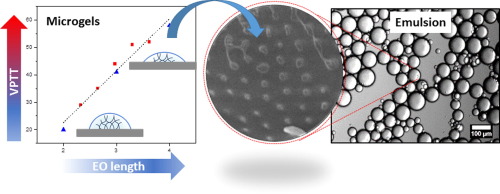M.-C. Tatry, P. Galanopoulo, L. Waldmann, V. Lapeyre, P. Garrigue, V. Schmitt, V. Ravaine
J. Colloid Interf. Sci., 2021, 589, 96-109
A series of biocompatible, thermoresponsive and amphiphilic poly(oligoethylene glycol)methacrylate (pOEMA) microgels is synthesized, with varying hydrophobic-hydrophilic balance, or equivalent varying volume phase transition temperature (VPTT). Their behavior in the bulk phase and at solid interfaces is compared to their behavior at liquid interfaces, studied on flat and model interfaces by the pendant drop method, and on drops, in microgel-stabilized emulsions. Controlling the composition of microgels by simply changing the number of ethylene oxide groups in the hydrophilic side chain allows a precise tuning of their VPTT in the range of 20–60 °C. Simultaneously, the swelling ratio and the deformability of the microgels increase by increasing the hydrophilicity, as a result of the polymerization process. Regardless of their hydrophilicity, all the swollen pOEMA microgels adsorb at the liquid interface and stabilize emulsions, whose flocculation state and mechanical stability depends on the microgel deformability. Unexpectedly, most emulsions remain stable upon heating above the VPTT of the microgels. Such feature highlights their extreme robustness, whose origin is discussed. This study opens new opportunities for the use of biocompatible Pickering emulsifiers.







